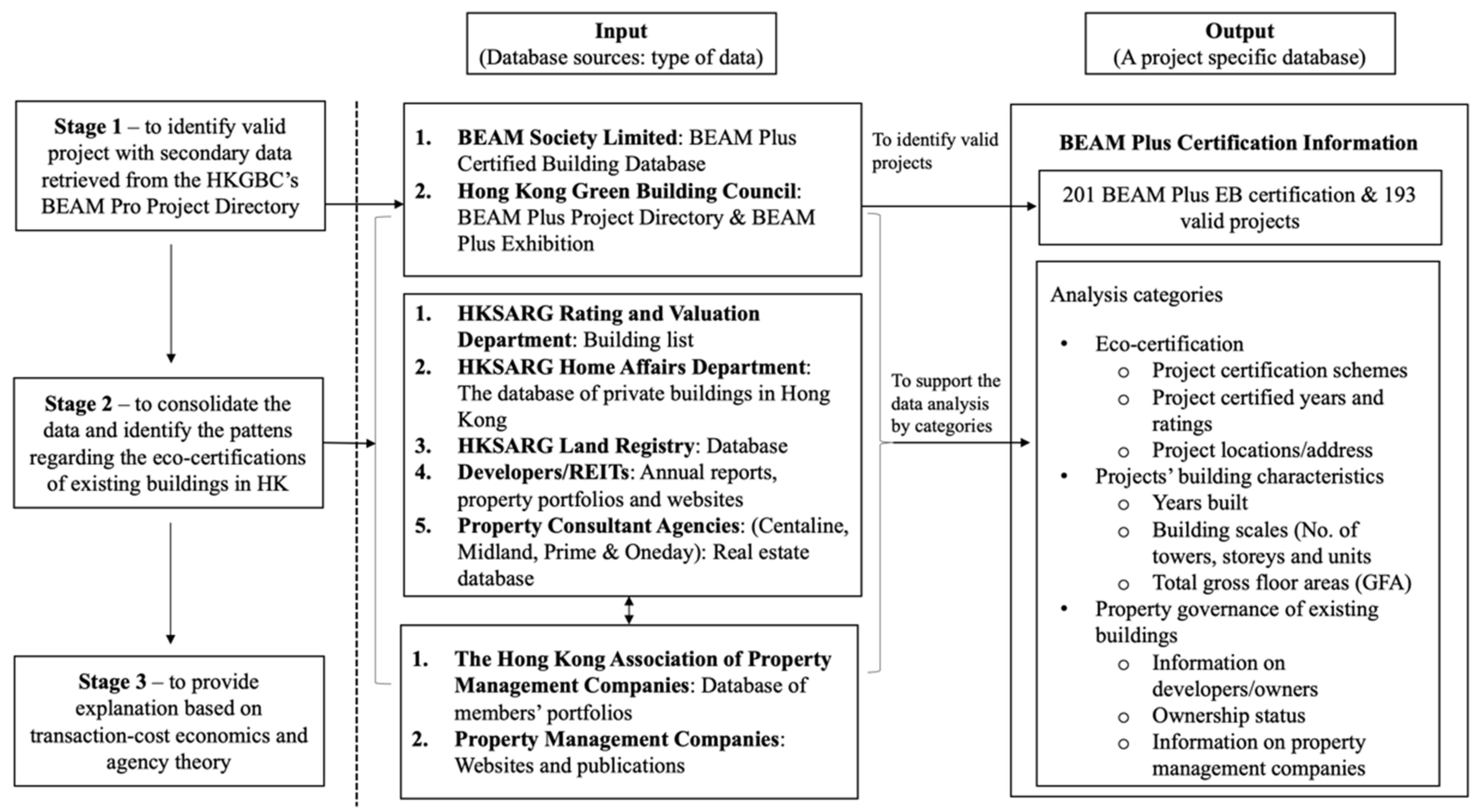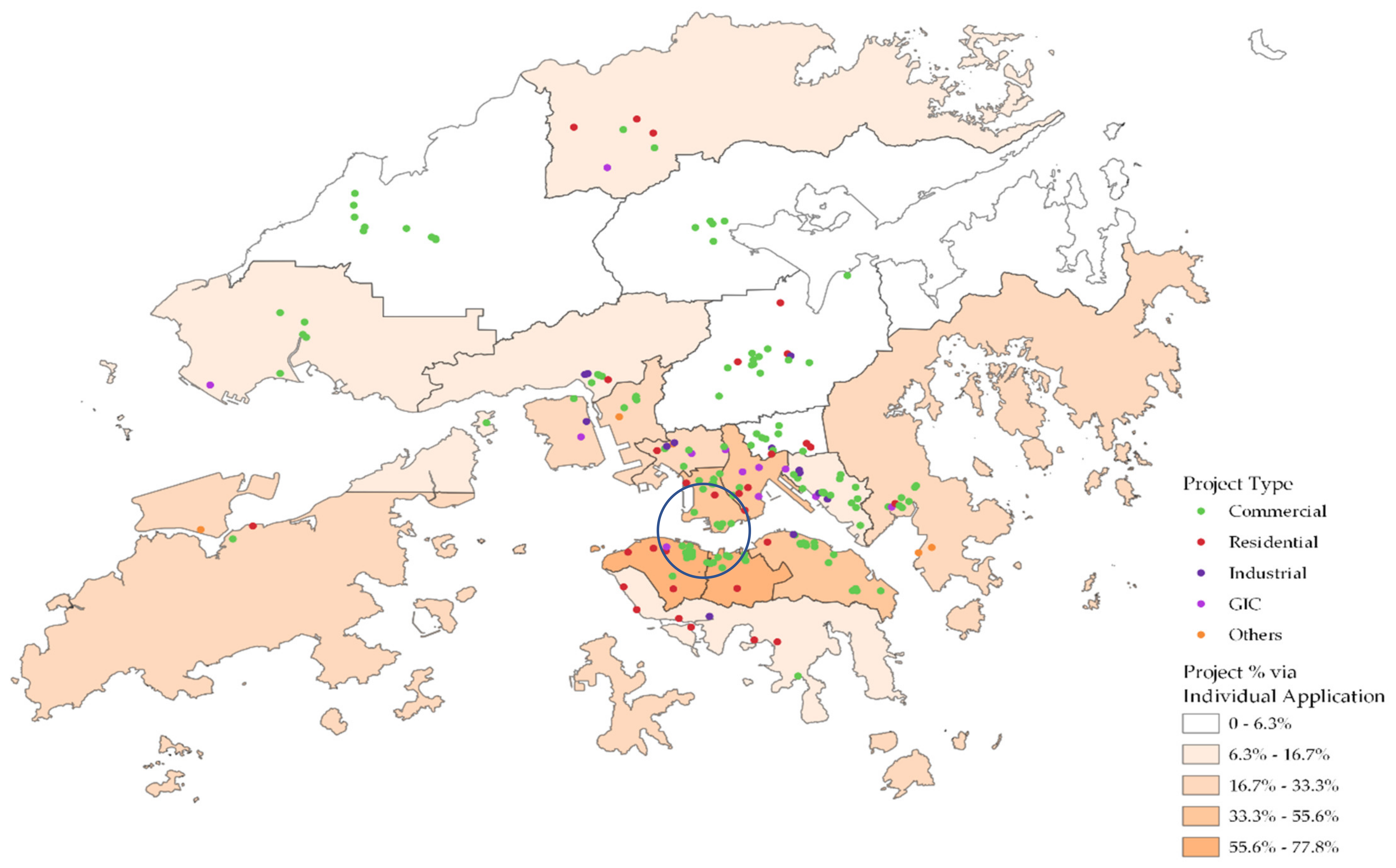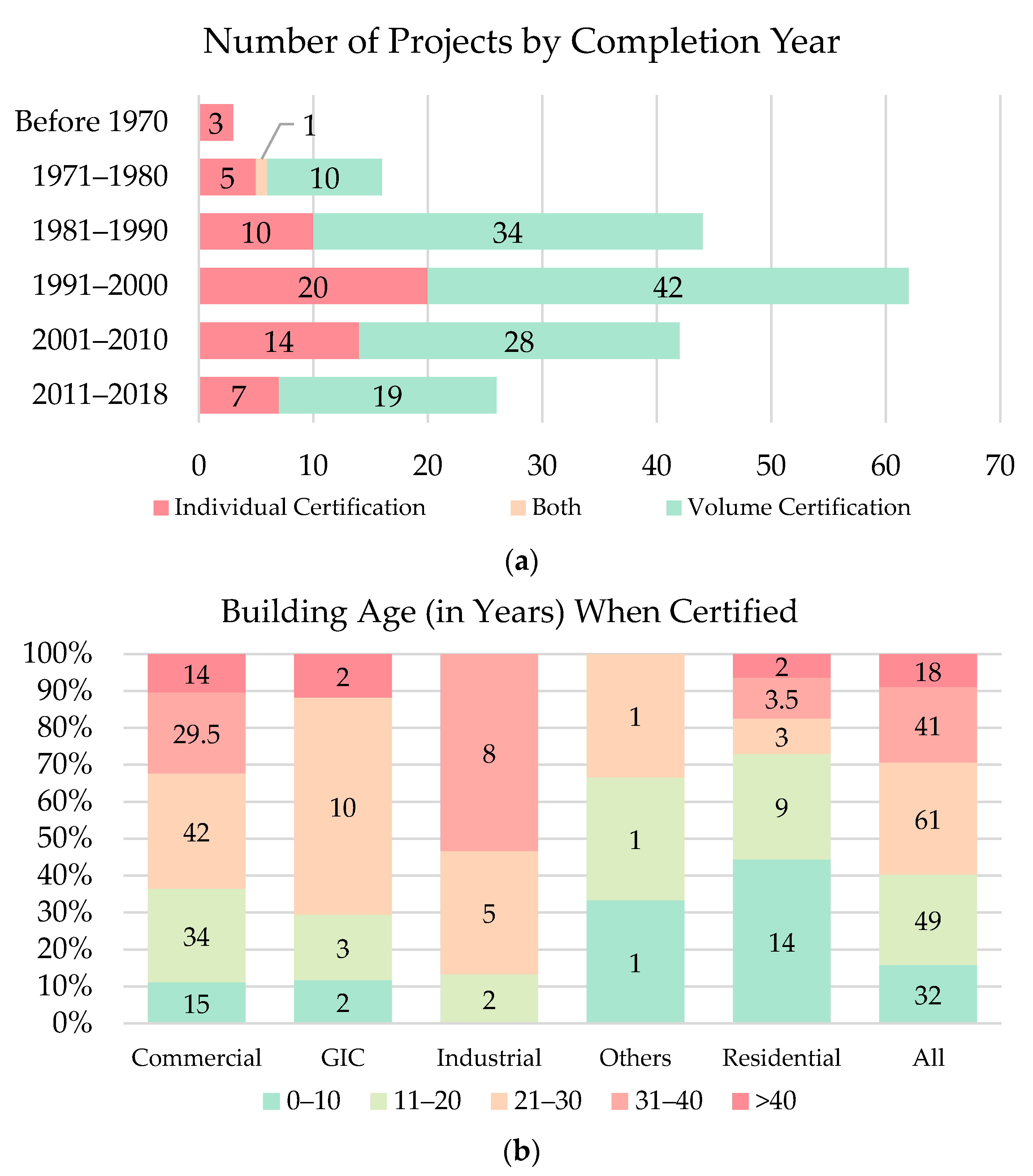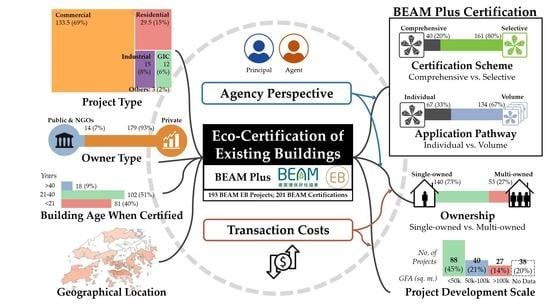Transaction Cost and Agency Perspectives on Eco-Certification of Existing Buildings: A Study of Hong Kong
Abstract
:1. Introduction
2. Context of the Research
2.1. Barriers to Building Energy Retrofits and Eco-Certification of Existing Building
2.2. Building Energy Retrofits and Eco-Certification in Hong Kong
2.2.1. Statutory Regulations and Policy Incentives for Building Energy Retrofits
2.2.2. Background of the BEAM Plus
2.3. A Transaction Cost (TC) and Agency Perspectives towards Building Energy Retrofits
3. Research Methodology and Data
4. Results
4.1. By Certification Schemes and Ratings
4.2. By Building Ownership Status, Project Types, and Sectors
4.3. By the Building/Estate Development Scale
4.4. By Regions and Districts
4.5. By Completion Years and Building Ages upon Certification
5. Discussion
5.1. Certification of Multi-Owned Properties Impeded by Institutional Settings
5.2. Agency Problems of Eco-Certification
5.3. Greater Drives for Certification of Privately Owned Commercial Properties
5.4. More Eco-Certifications with Building Energy Retrofits in the Non-Private Sector
6. Conclusions
Author Contributions
Funding
Institutional Review Board Statement
Informed Consent Statement
Data Availability Statement
Conflicts of Interest
References
- United Nations Environment Programme. 2020 Global Status Report for Buildings and Construction: Towards a Zero-Emission, Efficient and Resilient Buildings and Construction Sector; United Nations Environment Programme: Nairobi, Kenya, 2020. [Google Scholar]
- European Commission. In Focus: Energy Efficiency in Buildings. Available online: https://ec.europa.eu/info/news/focus-energy-efficiency-buildings-2020-feb-17_en (accessed on 25 May 2021).
- International Energy Agency. Policy Database. Available online: https://www.iea.org/policies (accessed on 25 May 2021).
- Chu, O.K.; Cheung, R.Y. A Comparison on Two Certification Systems: Leadership in Energy and Environmental Design (LEED) And Building Environmental Assessment Method (BEAM) On Green Building in Hong Kong. In Track 3: Advancing SBE Assessments. In Proceedings of the World Sustainable Built Environment Conference 2017, Hong Kong, China, 9 June 2017. [Google Scholar]
- Environment Bureau, Development Bureau, Transport and Housing Bureau. Energy Saving Plan for Hong Kong’s Built Environment 2015–2025+; Hong Kong SAR Government: Hong Kong, China, 2015.
- Liang, X.; Yu, T.; Hong, J.; Shen, G.Q. Making incentive policies more effective: An agent-based model for energy-efficiency retrofit in China. Energy Policy 2019, 126, 177–189. [Google Scholar] [CrossRef]
- Darko, A.; Chan, A.P. Review of barriers to green building adoption. Sustain. Dev. 2017, 25, 167–179. [Google Scholar] [CrossRef]
- Qian, Q.K.; Fan, K.; Chan, E.H.W. Regulatory incentives for green buildings: Gross floor area concessions. Build. Res. Inf. 2016, 44, 675–693. [Google Scholar] [CrossRef] [Green Version]
- Fan, K.; Chan, E.H.W.; Qian, Q.K. Transaction costs (TCs) in green building (GB) incentive schemes: Gross floor area (GFA) concession scheme in Hong Kong. Energy Policy 2018, 119, 563–573. [Google Scholar] [CrossRef]
- Friedman, C.; Becker, N.; Erell, E. Energy retrofit of residential building envelopes in Israel: A cost-benefit analysis. Energy 2014, 77, 183–193. [Google Scholar] [CrossRef]
- Fan, K.; Chan, E.H.W.; Chau, C.K. Costs and benefits of implementing green building economic incentives: Case study of a gross floor area concession scheme in Hong Kong. Sustainability 2018, 10, 2814. [Google Scholar] [CrossRef] [Green Version]
- Liu, Y.; Liu, T.; Ye, S.; Liu, Y. Cost-benefit analysis for Energy Efficiency Retrofit of existing buildings: A case study in China. J. Clean. Prod. 2018, 177, 493–506. [Google Scholar] [CrossRef]
- Olaussen, J.O.; Oust, A.; Solstad, J.T. Energy performance certificates—Informing the informed or the indifferent? Energy Policy 2017, 111, 246–254. [Google Scholar] [CrossRef] [Green Version]
- Olaussen, J.O.; Oust, A.; Solstad, J.T.; Kristiansen, L. Energy performance certificates: The role of the energy price. Energies 2019, 12, 3563. [Google Scholar] [CrossRef] [Green Version]
- Shaikh, P.H.; Shaikh, F.; Sahito, A.A.; Uqaili, M.A.; Umrani, Z. An Overview of the Challenges for Cost-Effective and Energy-Efficient Retrofits of the Existing Building Stock. In Cost-Effective Energy Efficient Building Retrofitting: Materials, Technologies, Optimization and Case Studies; Pacheco-Torgal, F., Granqvist, C., Jelle, B.P., Vanoli, G.P., Bianco, N., Kurnitski, J., Eds.; Woodhead Publishing: Cambridge, UK, 2017; pp. 257–278. [Google Scholar]
- Luther, M.B.; Rajagopalan, P. Defining and developing an energy retrofitting approach. J. Green Build. 2014, 9, 151–162. [Google Scholar] [CrossRef] [Green Version]
- Weiss, J.; Dunkelberg, E.; Vogelpohl, T. Improving policy instruments to better tap into homeowner refurbishment potential: Lessons learned from a case study in Germany. Energy Policy 2012, 44, 406–415. [Google Scholar] [CrossRef]
- Caputo, P.; Pasetti, G. Overcoming the inertia of building energy retrofit at municipal level: The Italian challenge. Sustain. Cities Soc. 2015, 15, 120–134. [Google Scholar] [CrossRef]
- Hong, T.; Piette, M.A.; Chen, Y.; Lee, S.H.; Taylor-Lange, S.C.; Zhang, R.; Sun, K.; Price, P. Commercial building energy saver: An energy retrofit analysis toolkit. Appl. Energy 2015, 159, 298–309. [Google Scholar] [CrossRef] [Green Version]
- Hou, J.; Liu, Y.; Wu, Y.; Zhou, N.; Feng, W. Comparative study of commercial building energy-efficiency retrofit policies in four pilot cities in China. Energy Policy 2016, 88, 204–215. [Google Scholar] [CrossRef]
- Building Performance Institute Europe. Europe’s Buildings under the Microscope—A Country-by-Country Review of the Energy Performance of Buildings; Buildings Performance Institute Europe: Brussel, Belgium, 2011. [Google Scholar]
- Amecke, H.; Deason, J.; Hobbs, A.; Novikova, A.; Xiu, Y.; Zhang, S. Buildings Energy Efficiency in China, Germany, and the United States; Climate Policy Initiative: San Francisco, CA, USA, 2013. [Google Scholar]
- Abdallah, M.; El-Rayes, K.; Liu, L. Minimizing upgrade cost to achieve LEED certification for existing buildings. J. Constr. Eng. Manag. 2016, 142, 04015073. [Google Scholar] [CrossRef]
- Aktas, B.; Ozorhon, B. Green building certification process of existing buildings in developing countries: Cases from Turkey. J. Manag. Eng. 2015, 31, 05015002. [Google Scholar] [CrossRef]
- Ma, Z.; Wang, S. Building energy research in Hong Kong: A review. Renew. Sustain. Energy Rev. 2009, 13, 1870–1883. [Google Scholar] [CrossRef]
- Electrical and Mechanical Services Department (EMSD). Hong Kong Energy Efficiency Registration Scheme for Buildings (2018 Edition). Available online: https://www.emsd.gov.hk/filemanager/en/content_723/hkeersb2018_en.pdf (accessed on 18 May 2021).
- Electrical and Mechanical Services Department (EMSD). Hong Kong Energy Efficiency Registration Scheme for Buildings. Available online: https://www.emsd.gov.hk/en/energy_efficiency/energy_efficiency_registration_scheme_for_building/index.html (accessed on 18 May 2021).
- Hong Kong Green Building Council (HKGBC). BEAM Plus—Introduction. Available online: https://www.hkgbc.org.hk/eng/beam-plus/introduction/index.jsp (accessed on 5 July 2021).
- Hong Kong Green Building Council, BEAM Society Limited. BEAM Plus Existing Buildings Version 2.0 (2016.03): Comprehensive Scheme; BEAM Society Limited: Hong Kong, China, 2016. [Google Scholar]
- Hong Kong Green Building Council, BEAM Society Limited. BEAM Plus Existing Buildings Version 2.0 (2016.03): Selective Scheme; BEAM Society Limited: Hong Kong, China, 2016. [Google Scholar]
- Coase, R.H. The Nature of the Firm. Economica 1937, 4, 386–405. [Google Scholar] [CrossRef]
- Coase, R.H. The Problem of Social Cost. J. Law Econ. 1960, 3, 1–44. [Google Scholar] [CrossRef]
- Gordon, R.L. Regulation and Economic Analysis: A Critique Over Two Centuries. Kluwer Academic Publishers: Dordrecht, The Netherlands, 1994. [Google Scholar]
- Williamson, O.E. Transaction-cost economics: The governance of control relations. J. Law Econ. 1979, 22, 233–261. [Google Scholar] [CrossRef]
- Williamson, O.E. The economics of Organization: The transaction cost approach. Am. J. Sociol. 1981, 87, 548–577. [Google Scholar] [CrossRef]
- Olson, M. The Logic of Collective Action: Public Goods and the Theory of Groups; Harvard University Press: Cambridge, MA, USA, 1965. [Google Scholar]
- Yau, Y. Multicriteria decision making for homeowners’ participation in building maintenance. J. Urban Plan. Dev. 2011, 138, 110–120. [Google Scholar] [CrossRef]
- Jia, L.; Qian, Q.K.; Meijer, F.; Visscher, H. Exploring key risks of energy retrofit of residential buildings in China with transaction cost considerations. J. Clean. Prod. 2021, 293, 126099. [Google Scholar] [CrossRef]
- Walker, A.; Chau, K.W. The relationship between construction project management theory and transaction cost economics. Eng. Constr. Archit. Manag. 1999, 6, 166–176. [Google Scholar] [CrossRef]
- Ahn, Y.H.; Pearce, A.R. Green construction: Contractor experiences, expectations, and perceptions. J. Green Build. 2007, 2, 106–122. [Google Scholar] [CrossRef]
- Meacham, B.J. Accommodating innovation in building regulation: Lessons and challenges. Build. Res. Inf. 2010, 38, 686–698. [Google Scholar] [CrossRef]
- Chai, K.; Yeo, C. Overcoming energy efficiency barriers through systems approach—A conceptual framework. Energy Policy 2012, 46, 460–472. [Google Scholar] [CrossRef]
- Qi, G.Y.; Shen, L.Y.; Zeng, S.X.; Jorge, O.J. The drivers for contractors’ green innovation: An industry perspective. J. Clean. Prod. 2010, 18, 1358–1365. [Google Scholar] [CrossRef]
- Häkkinen, T.; Belloni, K. Barriers and drivers for sustainable building. Build. Res. Inf. 2011, 39, 239–255. [Google Scholar] [CrossRef]
- Jensen, M.; Meckling, W. Theory of the firm: Managerial behaviour, agency costs, and ownership structure. J. Financ. Econ. 1976, 3, 305–360. [Google Scholar] [CrossRef]
- Moore, J.H. Agency costs, technical change and Soviet central planning. J. Law Econ. 1981, 24, 189–214. [Google Scholar] [CrossRef]
- Fama, E.; Jensen, M. Separation of ownership and control. J. Law Econ. 1983, 26, 301–326. [Google Scholar] [CrossRef]
- Rauchhaus, R.W. Principal-agent problems in humanitarian intervention: Moral hazards, adverse selection, and the commitment dilemma. Int. Stud. Q. 2008, 53, 871–884. [Google Scholar] [CrossRef]
- Fayezi, S.; O’Loughlin, A.; Zutshi, A. Agency theory and supply chain management: A structured literature review. Supply Chain Manag. 2012, 17, 556–570. [Google Scholar] [CrossRef] [Green Version]
- Calvo, N.; Calvo, F. Corporate social responsibility and multiple agency theory: A case study of internal stakeholder engagement. Corp. Soc. Responsib. Environ. Manag. 2018, 25, 1223–1230. [Google Scholar] [CrossRef]
- Delbufalo, E. Agency Theory and Sustainability in Global Supply Chain. In Agency Theory and Sustainability in the Global Supply Chain; Springer: Cham, Switzerland, 2018; pp. 33–54. [Google Scholar]
- Kumbaroğlu, G.; Madlener, R. Evaluation of economically optimal retrofit investment options for energy savings in buildings. Energy Build. 2012, 49, 327–334. [Google Scholar] [CrossRef]
- Development Bureau, Planning Department. Hong Kong 2030+: Towards a Planning Vision and Strategy Transcending 2030; Hong Kong SAR Government: Hong Kong, China, 2016; pp. 45–46.
- ESRI China (HK). Hong Kong 18 Districts. Available online: https://opendata.esrichina.hk/datasets/eea8ff2f12b145f7b33c4eef4f045513_0/explore?location=22.357821%2C114.139117%2C11.58&showTable=true (accessed on 9 June 2021).
- Audit Commission. Director of Audit’s Report No. 75; Audit Commission: Hong Kong, China, 2020.
- Altmann, E. Apartments, co-ownership and sustainability: Implementation barriers for retrofitting the built environment. J. Environ. Policy Plan. 2014, 16, 437–457. [Google Scholar] [CrossRef]
- Bright, S.; Weatherall, D. Framing and mapping the governance barriers to energy upgrades in flats. J. Environ. Law 2017, 29, 203–229. [Google Scholar] [CrossRef]
- Maruejols, L.; Young, D. Energy Use in Canadian Multi-Family Dwellings; Canadian Building Energy End-Use Data and Analysis Centre: Edmonton, AB, Canada, 2010. [Google Scholar]
- The Hong Kong Institute of Surveyors. Standard Property Management Agreement; The Hong Kong Institute of Surveyors: Hong Kong, China, 2013. [Google Scholar]
- Property and Facility Management Division of the Hong Kong Institute of Surveyors. Benchmarking of Management Fees for Office Buildings in Hong Kong; The Hong Kong Institute of Surveyors: Hong Kong, China, 2010. [Google Scholar]
- Yau, Y.; Ho, D.C.W.; Li, R. Benchmarking property management agents’ performance in Hong Kong. Int. J. Dev. Sustain. 2017, 6, 650–666. [Google Scholar]
- Gao, L.W.; Ho, D.C.W. Explaining the outcomes of multi-owned housing management: A collective action perspective. Habitat Int. 2016, 57, 233–241. [Google Scholar] [CrossRef]
- Chu, F.-N.; Chang, C.-O. Performance evaluation of condominium management and maintenance modes: From a perspective of principal-agent relationship. Manag. Rev. 2013, 32, 123–130. [Google Scholar]
- Jones Lang Lasalle. The Impacts of Sustainability on Value: Developing the Business Case for Net Zero Carbon Buildings in Central London; Jones Lang Lasalle: London, UK, 2020. [Google Scholar]
- Matisoff, D.C.; Noonan, D.S.; Mazzolini, A.M. Performance or marketing benefits? The case of LEED certification. Environ. Sci. Technol. 2014, 48, 2001–2007. [Google Scholar] [CrossRef] [Green Version]
- Bower, B.; Boyd, N.; McGoun, E. Greenbacks, green banks, and greenwashing via LEED: Assessing banks’ performance in sustainable construction. Sustain. J. Rec. 2020, 13, 208–217. [Google Scholar] [CrossRef]
- Eichholtz, P.; Kok, N.; Quigley, J.M. Why companies rent green: CSR and the role of real estate? Inst. Bus. Econ. Res. 2017, 2009, W09-004. [Google Scholar] [CrossRef]
- Eichholtz, P.; Kok, N.; Quigley, J.M. The economics of green buildings. Rev. Econ. Stat. 2013, 95, 50–63. [Google Scholar] [CrossRef]
- Wadu, M.J.; Chan, H.T. Environmental certification schemes and property values: Evidence from the Hong Kong prime commercial office market. Int. J. Strateg. Prop. Manag. 2019, 23, 81–95. [Google Scholar]
- Li, W.; Fang, G.; Yang, L. The effect of LEED certification on office rental values in China. Sustain. Energy Technol. Assess. 2021, 45, 101182. [Google Scholar]
- Collins, D.; Junghans, A.; Haugen, T. Green leasing in commercial real estate: The drivers and barriers for owners and tenants of sustainable office buildings. J. Corp. Real Estate 2018, 20, 244–259. [Google Scholar] [CrossRef]
- Wrigley, K.; Crawford, R.H. Identifying policy solutions for improving the energy efficiency of rental properties. Energy Policy 2017, 108, 369–378. [Google Scholar] [CrossRef]
- Yang, E.; Guevara-Ramirez, J.S.; Bisson, C. Finding evidence of green leasing in United States government-leased properties. J. Green Build. 2020, 15, 55–72. [Google Scholar] [CrossRef]
- Qiu, Y.L.; Su, X.; Wang, D. Factors influencing commercial buildings to obtain green certificates. Appl. Econ. 2017, 49, 1937–1949. [Google Scholar] [CrossRef]



| Certification Scheme | No. and Percentage | Aspect | No. and Percentage |
|---|---|---|---|
| BEAM EB Version 1.1 and Version 1.2 | 10 (5.0%) | - | - |
| BEAM EB Version 2.0 (Comprehensive Scheme) | 30 (14.9%) | - | - |
| BEAM EB Version 2.0 (Selective Scheme) | 161 (80.1%) 1 | Management | 143 (88.8%) 2 |
| Site | 4 (2.5%) | ||
| Materials and Waste | 1 (0.6%) | ||
| Energy Use | 10 (6.2%) | ||
| Water Use | 2 (0.6%) | ||
| Indoor Environmental Quality | 1 (0.6%) |
| Rating | No. via Individual Certification | No. via Volume Certification | Overall |
|---|---|---|---|
| Final platinum/excellent | 57 (85.1%) | 10 (7.5%) | 67 (33.3%) |
| Final gold/very good | 4 (6.0%) | 0 (0%) | 4 (2.0%) |
| Final silver/good | 3 (4.5%) | 124 (92.5%) | 127 (63.2%) |
| Final bronze/satisfactory | 3 (4.5%) | 0 (0%) | 3 (1.5%) |
| Total | 67 (100%) | 134 (100%) | 201 (100%) |
| Project Type/Ownership Status | No. of Projects | Percentage of Projects | |||||||
|---|---|---|---|---|---|---|---|---|---|
| Public | NGO | Private | Overall | Public | NGO | Private | Overall | ||
| Commercial | Total | 0 | 0 | 133.5 4 | 133.5 | 0% | 0% | 100% | 100% |
| SO 1 | 0 | 0 | 119 | 119 | 0% | 0% | 100% | 89.1% | |
| MO 2 | 0 | 0 | 14.5 | 14.5 | 0% | 0% | 100% | 10.9% | |
| Residential | Total | 1 | 1 | 27.5 | 29.5 | 3.4% | 3.4% | 93.2% | 100% |
| SO | 1 | 1 | 1 | 3 | 33.3% | 33.3% | 33.3% | 10.2% | |
| MO | 0 | 0 | 26.5 | 26.5 | 0% | 0% | 100% | 89.8% | |
| Industrial | Total | 0 | 0 | 15 | 15 | 0% | 0% | 100% | 100% |
| SO | 0 | 0 | 3 | 3 | 0% | 0% | 100% | 20.0% | |
| MO | 0 | 0 | 12 | 12 | 0% | 0% | 100% | 80.0% | |
| Government/Institution or Community (GIC) | Total | 10 | 2 | 0 | 12 | 83.3% | 16.7% | 0% | 100% |
| SO | 10 | 2 | 0 | 12 | 83.3% | 16.7% | 0% | 100% | |
| MO | 0 | 0 | 0 | 0 | 0% | 0% | 0% | 0% | |
| Other Types 3 | Total | 0 | 0 | 3 | 3 | 0% | 0% | 100% | 100% |
| SO | 0 | 0 | 3 | 3 | 0% | 0% | 100% | 100% | |
| MO | 0 | 0 | 0 | 0 | 0% | 0% | 0% | 0% | |
| All | Total | 11 | 3 | 179 | 193 | 5.7% | 1.6% | 92.7% | 100% |
| SO | 11 | 3 | 126 | 140 | 7.9% | 2.1% | 90.0% | 72.5% | |
| MO | 0 | 0 | 53 | 53 | 0% | 0% | 100% | 27.5% | |
| Property Owner/Developer (Parent Organization) 1 | HKGBC Patronship | No. of BEAM-Certified Existing Buildings | Average Rating Score 2 | ||
|---|---|---|---|---|---|
| via Individual Certification | via Volume Certification | All | |||
| Public Sector | 11 | 0 | 11 | 1.46 | |
| HKSAR Government | - | 8 | 0 | 8 | 1.38 |
| University of Hong Kong | Marble | 1 | 0 | 1 | 1.00 |
| Vocational Training Council | - | 2 | 0 | 2 | 2.00 |
| NGO | 3 | 0 | 3 | 1.67 | |
| Business Environment Council | - | 1 | 0 | 1 | 1.00 |
| Hong Kong Housing Society | - | 1 | 0 | 1 | 3.00 |
| Tung Wah Group of Hospitals | - | 1 | 0 | 1 | 1.00 |
| Private Sector | 45 | 134 | 179 | 2.43 | |
| CK Asset Holding | - | 1 | 0 | 1 | 1.00 |
| Ever Gain Plaza Management | - | 1 | 0 | 1 | 2.00 |
| Gammon Construction | Marble | 1 | 0 | 1 | 1.00 |
| Great Eagle Holdings | Silver | 1 | 0 | 1 | 1.00 |
| Hang Lung Group | Gold | 4 | 0 | 4 | 1.25 |
| Henderson | Gold | 1 | 0 | 1 | 1.00 |
| HKEX | - | 1 | 0 | 1 | 1.00 |
| Hongkong Land | Gold | 6 | 0 | 6 | 1.00 |
| Hysan Development | Gold | 2 | 0 | 2 | 1.00 |
| Link REIT | Gold | 0 | 50 | 50 | 1.67 |
| Mapletree | - | 1 | 0 | 1 | 3.00 |
| MTR Corporation | - | 1 | 0 | 1 | 1.00 |
| Nan Fung Group | Gold | 0 | 12 | 12 | 2.00 |
| New World Development | Platinum | 3 | 0 | 3 | 3.00 |
| Pacific Century Premium Developments | - | 1 | 0 | 1 | 1.00 |
| Paramatta Estate Management | - | 1 | 0 | 1 | 1.00 |
| Shui On Group | - | 1 | 0 | 1 | 4.00 |
| Sino | Gold | 3 | 0 | 3 | 2.00 |
| Sun Hung Kai Properties | Gold | 4 3 | 72 3 | 75 | 2.64 |
| Swire | Platinum | 13 | 0 | 13 | 1.00 |
| Total | 60 3 | 134 3 | 193 | – | |
| Average Rating Score | 2.86 | 1.25 | 2.36 | – | |
| Property Owners/Developers (Parent Company) | Property Management Company (PMC) | No. of Projects under the Same Group |
|---|---|---|
| CK Asset Holding Limited | Goodwell Property Management Ltd. | 1 |
| Gammon Construction | Gammon Construction Ltd. | 1 |
| Great Eagle Holdings | Keysen Property Management Services Ltd. | 1 |
| Hang Lung Group | Hang Lung Properties Ltd. | 4 |
| Henderson | Henderson Sunlight Property Management Ltd. | 1 |
| HKEX | Hong Kong Exchanges and Clearing Ltd. | 1 |
| Hongkong Land | Hongkong Land Group Ltd. | 6 |
| Hysan Development | Hysan Property Management Ltd. | 2 |
| Link REIT |
| 50 |
| Mapletree | Mapletree North Asia Property Management Ltd. | 1 |
| MTR Corporation | MTR Corporation Ltd. | 1 |
| Nan Fung Group |
| 12 |
| New Charm Management Ltd. | ||
| New World Development | Urban Property Management Ltd. | 3 |
| Pacific Century Premium Developments | Island South Property Management Ltd. | 1 |
| Paramatta Estate Management | Paramatta Estate Management Ltd. | 1 |
| Shui On Group | Shui On Centre Property Management Ltd. | 1 |
| Sino Group | Sino Estates Management Ltd. | 3 |
| Sun Hung Kai Properties |
| 75 |
| Swire | Swire Properties Management Ltd. | 13 |
| Total | 178 |
| Equal Interval | Natural Break (Jenks) | ||
|---|---|---|---|
| No. of Residential Units | No. (%) of BEAM EB Residential Projects | No. of Residential Units | No. (%) of BEAM EB Residential Projects |
| 10–916 | 20 (69.0%) | 10–264 | 11 (37.9%) |
| 917–1823 | 5 (17.2%) | 265–723 | 9 (31.0%) |
| 1824–2729 | 2 (6.9%) | 724–1159 | 4 (13.8%) |
| 2730–3636 | 0 (0%) | 1160–2771 | 3 (10.3%) |
| 3637–4542 | 2 (6.9%) | 2772–4542 | 2 (6.9%) |
| Overall | 29 (100%) | Overall | 29 (100%) |
| Project Scale 2 | Corresponding Construction Floor Area (sq. m.) 2 | No. (%) of BEAM Plus EB Projects | No. (%) of Projects Achieving BEAM “Energy Use” Performance 3 |
|---|---|---|---|
| Extra small (ES) | ≤2499 | 2 (1.3%) | 2 (1.3%) |
| Small (S) | 2500–24,999 | 49 (31.6%) | 10 (6.4%) |
| Medium (M) | 25,000–49,999 | 37 (23.9%) | 8 (5.2%) |
| Large (L) | 50,000–99,999 | 40 (25.8%) | 15 (9.7%) |
| Extra large (EL) | 100,000–199,999 | 22 (14.2%) | 7 (4.5%) |
| Mega large (MG) | 200,000–400,000 | 4 (2.6%) | 2 (1.3%) |
| Exceptional Scale | >400,000 | 1 (0.6%) | 0 (0%) |
| Overall | 155 (100%) | 44 (28.4%) | |
| Region | % of Projects via Individual Certification (N = 60) | % of Projects (All Pathways) (N = 193) | ||||||||||
|---|---|---|---|---|---|---|---|---|---|---|---|---|
| C | R | I | GIC | OU | All | C | R | I | GIC | OU | All | |
| Hong Kong Island | 73.2% | 40.0% | 0% | 8.3% | 0% | 55.0% | 30.5% | 40.7% | 14.3% | 8.3% | 0% | 29.0% |
| Kowloon | 19.5% | 40.0% | 0% | 58.3% | 0% | 28.3% | 30.5% | 30.5% | 50.0% | 58.3% | 0% | 33.2% |
| New Territories | 7.3% | 20.0% | 0% | 33.3% | 100% | 16.7% | 39.0% | 28.8% | 35.7% | 33.3% | 100% | 37.8% |
| Overall | 100% | 100% | 0% | 100% | 100% | 100% | 100% | 100% | 100% | 100% | 100% | 100% |
Publisher’s Note: MDPI stays neutral with regard to jurisdictional claims in published maps and institutional affiliations. |
© 2021 by the authors. Licensee MDPI, Basel, Switzerland. This article is an open access article distributed under the terms and conditions of the Creative Commons Attribution (CC BY) license (https://creativecommons.org/licenses/by/4.0/).
Share and Cite
Yau, Y.; Hou, H.; Yip, K.C.; Qian, Q.K. Transaction Cost and Agency Perspectives on Eco-Certification of Existing Buildings: A Study of Hong Kong. Energies 2021, 14, 6375. https://doi.org/10.3390/en14196375
Yau Y, Hou H, Yip KC, Qian QK. Transaction Cost and Agency Perspectives on Eco-Certification of Existing Buildings: A Study of Hong Kong. Energies. 2021; 14(19):6375. https://doi.org/10.3390/en14196375
Chicago/Turabian StyleYau, Yung, Huiying (Cynthia) Hou, Ka Chi Yip, and Queena Kun Qian. 2021. "Transaction Cost and Agency Perspectives on Eco-Certification of Existing Buildings: A Study of Hong Kong" Energies 14, no. 19: 6375. https://doi.org/10.3390/en14196375
APA StyleYau, Y., Hou, H., Yip, K. C., & Qian, Q. K. (2021). Transaction Cost and Agency Perspectives on Eco-Certification of Existing Buildings: A Study of Hong Kong. Energies, 14(19), 6375. https://doi.org/10.3390/en14196375





_Hou.png)




